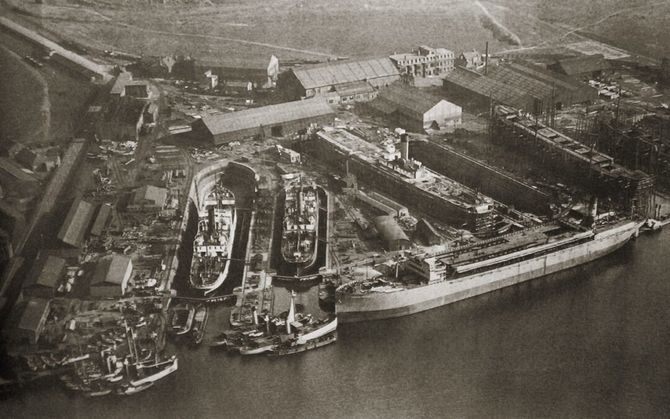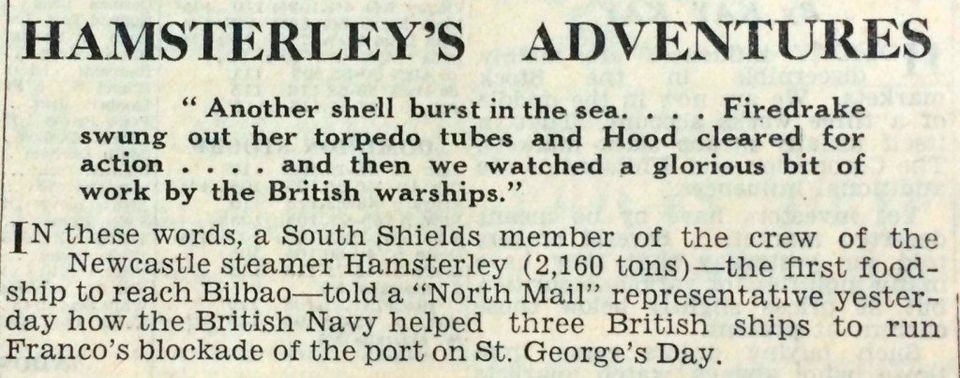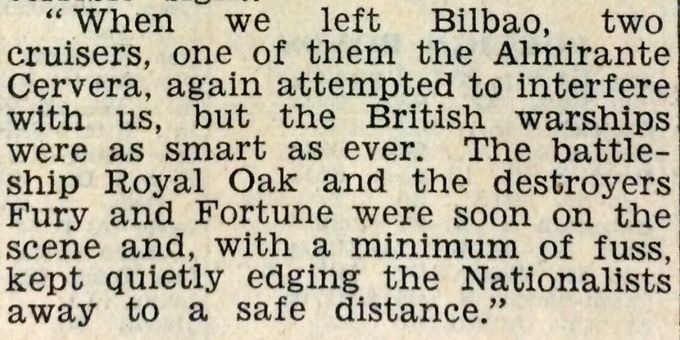Left ... The SS Hamsterley. Type, cargo vessel. Three island type, engines and bridge midships, four holds, poop deck, bridge deck and forecastle, plumb bow and counter stern.
Above ... Smith Docks Co Ltd, circa 1928 (builders of the Hamsterley)
Hamsterley SS
Position ... 52 51'13,2 N / 01 42'43,9 EBuilt ... 1925Builder ... Smiths Dock Co Ltd, South Bank and StocktonDimensions ... 280 x 41.6 x 20.1 feetYard number ... 800Engine ... 3 cylinder triple expansion (20.5, 33, 54 x 39 inchesEngine builder ... Smiths Dock Co LtdBoilers ... x2 Scotch type boilers / x6 corrugated furnaces in totalLost ... 3 / 12 / 1939Cause ... Collision)wner at time of liss ... Hartley Steam Ship Company, NewcastleCargo ... In ballastPower ... 201 nhp x 1 propSpeed ... 10 knotsTonnage ... 2160 grtConstruction ... SteelLives lost ... x1 / Achmed Fakir - Donkeyman
Circumstances of loss
Sank whilst on passage from London to Hartlepool after being in collision with the SS Accrington, this being some 3 miles south of the Haisborough Light Vessel.
History of ownership
Built as the Hamsterley in 1925 by Smith Docks Co Ltd for the Hartlepool Steam Ship Company. The Hartlepool company retained ownership of the Hamsterley up until the time of her loss in 1939.
UKHO
1941 ... Swept clear at 42 feet. Least depth 90 feet in 20 fathoms (120 feet, 36 mtrs)
1980 ... Least depth 27.3 mtrs in a general depth of 38 mtrs. Scour depth 39 mtrs. Height 7 mtrs / Length 100 mtrs.
2015 ... Least depth 27.2 mtrs, length 85 mtrs, width 15 mtrs, height 10.5 mtrs
Spanish Civil War
During the Spanish Civil War, the year being 1937, the hamsterley found herself employed in the shipment of food stuffs to the bombed out citizens of the ancient city of Guernica. The bombing of Guernica was carried out by German aircraft in support of the Nationalist leader General Franco. The Civil war was a result of the Nationalists launching attacks in order to overthrow the democratically elected Republican government.
Guernica was a civilian target and in turn held no strategic value. The horror of the events sent shock waves throughout the world. Guernica is 35 kilimeters from the port of Bilbao where the Hamsterley along with two other food ships were docked.
In order to reach Bilbao, the Hamsterley had to run the Nationalist blockade, this being imposed on March 31st. The blockade resulted in threats from the Nationalists to sink any British ships approaching Republican held ports
Below ... A newspaper clipping reporting the events of the Hamsterley running the Nationalist blockade.
Below ... The report as stated above in the newspaper clipping of one of the crews account of the Hamsterley running the Nationalist blockade.
…the Almirante Cervera … signalled to us to stop. When we failed to do so, she showed her disapproval by sending a shell across our bows. … Firedrake darted in between us and the Nationalist cruiser.… We carried on again towards Bilbao and were at the head of the convoy when another shell burst in the sea. … Firedrake swung out her torpedo tubes and Hood cleared her decks for action. Her mighty guns looked terrifying. Firedrake signalled to the trawler Galerna that she must not meddle with British ships… The trawler tried to get in between us and the three-mile limit [international waters start 3 miles from the coast] but Firedrake headed her off until we had passed inside the limit. Then the Galerna tried to reach us again, but the shore batteries at Bilbao opened fire…
On the return trip from Bilbao, the Hamsterley once again had to run the blockade. Below is a newspaper clipping reporting the Captain of the Hamsterley's account of the event.
The Nationalists won the war which ended in 1939 and remained in power until 1975 when Franco died.
The Hamsterley today
Awaiting divers report






